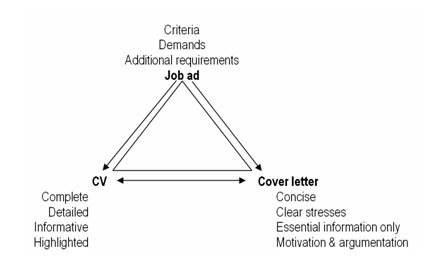Carefully read the job ad for which you'd like to apply and for which you have already written a CV. Consider your CV along with the information you have found on the employer and the vacancy. These sources of information can all be sources of inspiration. If you have completed the job orientation module, decide on which results to include in your letter.
Next, grab a pencil and mark the ad:
- write a plus-sign next to the requirements you meet
- put a minus next to the requirements you don't meet
- write a plus-minus next to the requirements you meet partially
You can also mark the elements from your CV that you'd like to use in your letter.
The job ad determines both the order and structure of your CV as the content of your letter. Remember however, that a CV should be thorough and complete but a cover letter can only be used to stress specific elements from your CV.
Your CV is the starting point of your written application; the cover letter is an important source of additional information in which you link the facts from your CV. Visually you could picture the relationship between ad, CV and letter as such:

Write a first draft of your cover letter according to the following structure: motivation - argumentation - extra assets.
Motivation
Write a clear answer to the following questions:
- Why do I want to work for this employer?
- Why do I want this job exactly?
Argumentation
Write a clear answer to the following questions:
- What are my three most important assets to highlight?
- What is my most important asset to highlight?
Do not neglect to support your argumentation with facts, but do not offer too many details.
Extra assets
Have you got any additional qualities which deserve to be mentioned? Consider courses, trainings, relevant non-professional experiences.
Are there any requirements in the ad you do not fully live up to (minuses and plus-minuses)?
While writing, do not lose sight of the length of your letter.